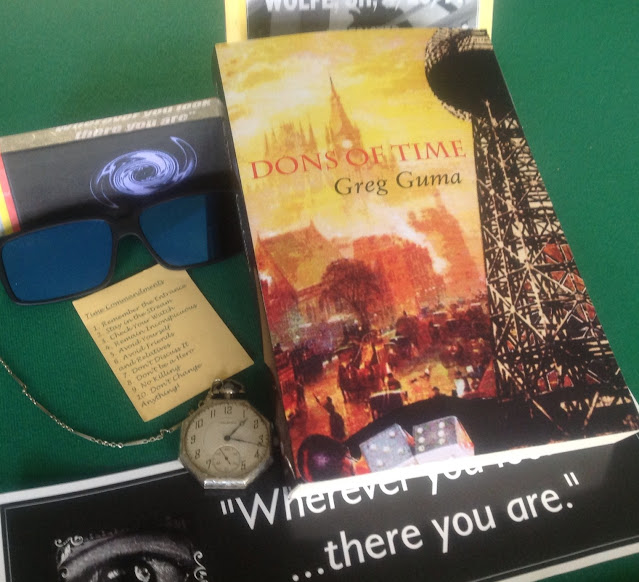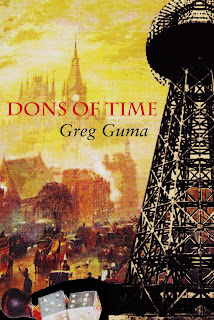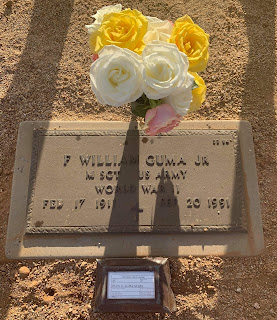We can't just buy, build or bully our way out of problems. But we do have another choice: learn from the past, open up the debate, and build a movement for preservation & change.
Wednesday, October 28, 2020
DONS OF TIME: Wherever You Look There You Are
Tuesday, October 27, 2020
The Vortex: Exploring the Smoke Rings of History
 They drove along the Rim Road and stopped at a turnout to walk the edge of the Colorado Plateau and take in the valley below.
They drove along the Rim Road and stopped at a turnout to walk the edge of the Colorado Plateau and take in the valley below.The Yavapai and later the Tonto Apache were drawn to this area more than a millennium ago. But the Army drove them off in the 1870s after gold was discovered near Prescott. He remembered the story. In the summer of 1882, not far from where they were standing on the Mongollon Rim, the high escarpment of the plateau that ran across central Arizona, the Apache had made their last stand.
The drive had been soothing, and when they reached the plateau Ryan Crown began with the tale of Nock-ay-del-klinne, the Apache medicine man who had set the battle in motion. Nock-ay-del-kinne had begun a ghost dance cult, he said, and had predicted that dead warriors would return and lead them to victory. The Army was worried enough to send almost two hundred soldiers from Fort Apache to arrest him. In the shootout that followed the medicine man was killed and the troops were slaughtered. But the uprising ended when the Army tracked a band of Apaches to the rim just north of Payson and killed most of them.
The Yavapai and Apaches recognized the natural energy of the area, Crown said. They didn’t need shiny scientific toys to sense that powerful forces were at work. He talked about the abundance of Iron Oxide, which gave the soil, the rocks, even the bark of trees their reddish hue. That and other metals and minerals common to the area helped to focus the earth’s geomagnetism, produced by its molten outer core. Below the surface quartz was embedded in the sandstone. Years of research with Fluxgate magnetometers and induction coils confirmed the intensity of the resulting electromagnetic activity, he explained.
As stimulating as he found such ideas he couldn’t turn off the other questions collecting and colliding in his brain or the roiling emotions they reinforced. Crown recognized the problem and shifted the conversation, pivoting to a recap of government experiments with paranormal abilities, beginning with hypnosis in World War II. The classic Hitchcock movie The 39 Steps turns out to be pretty close. Hypnosis was used with couriers, apparently splitting their personalities so that one could remember a secret message while the other wouldn’t be aware of it or crack under pressure.
Hypnosis was also used to increase endurance and reduce sensitivity to pain, a useful ability if a spy was captured and tortured. This was an early inkling of the deadly dream, Crown explained, the goal of creating super-soldiers. The Nazis tried it without success, and ironically enough, many of the same training techniques were also used traditionally in Shamanic rituals. One example had been put on public display in A Man Called Horse when Richard Harris was suspended from hooks in his final test for admission to the tribe.
In 1983, while Crown was recording the images of remote viewers, the army was pursuing the Jedi Project. Visualization, positive reinforcement and suggestion became tools to increase concentration and willpower. They were the keys to high performance in battle, while neuro-linguistic programming accelerated the training.
Over time, however, Crown lost faith in the government’s intentions. He accepted the need for a strong national defense, even the use of hypnosis, remote viewing and paranormal abilities, but he began to notice a shift to the dark side — aggressively preemptive methods — as well as a tendency to classify political opponents as threats. Remote viewing as reconnaissance was one thing, telepathic projection was another. Research was underway on how to exert remote influence on blood pressure, respiration and other functions, and how infrasound and ultrasound could be used to kill.
He claimed to have no direct knowledge of what DARPA was doing then, or of the specific tests Tonio Wolfe had undergone long ago. From his descriptions and Crown’s own knowledge of the agency, however, he speculated that it was probably connected to aerospace research. Children were considered good test subjects because they reacted more spontaneously and had fewer preconceptions. They might also have been looking for kids who showed above-average potential for NASA or other space program projects, perhaps trolling for the astronauts of the future.
That made it sound only slightly less offensive.
Once they were back from walking the Rim for an hour, Crown suggested that Tonio could use some time “off the grid,” a period with no email or calls, time and space to get centered. It sounded like the right idea.
“When?”
“Right now. I have gear in the trunk, sleeping bags, food, everything we need.” Tonio hesitated. “Be prepared, the scouts have at least one thing right.”
That night they camped at the foot of Schnebly Hill, a high plateau with views of Sedona and Oak Creek Canyon. After dinner Crown turned the discussion to what he had learned since leaving the government. The techniques he and others were attempting to control in the service of national security had existed for millennia, he said. In ancient Mexico Aztec dream interpreters used sleep deprivation and drugs to sharpen their minds and, so they claimed, travel through space to spy on enemies. Remote viewing, Crown suggested, might be a modern version of what was once called soul traveling.
He explained that human beings specialized in mastering their power to reason, and also gave considerable attention to their emotions. What they did not practice nearly enough was the control of dreams and will. The focus on reason reinforces our ordinary perception of the world and the “rules” we believe govern it, he said. But it is also possible to transcend reason and mobilize the will.
Beyond the personal level, he said, there are places that can amplify natural abilities, some of them conducive to introspection, others more helpful with skill development or expanded consciousness. Schnebly Hill was such a place, he said, a center of energy that can heal and purify.
Tonio wanted to object. He had heard his mother enthuse about Sedona’s vortices, places where the earth’s energy is somehow enhanced and helps with self-awareness and health. Tourists treated them like spiritual hot tubs. As a teen he had witnessed hundreds of believers, his mother among them, waiting at Bell Rock in 1987. They had convinced themselves that the top of the rock would open to reveal an alien craft. The fact that nothing happened failed to prevent people from believing that the area was a vortex buffet.
Sensing the skepticism Crown returned to basics — the spinning motion around an imaginary axis known as vortical flow. He pointed out that vortices exist in numerous forms — stirred liquids, smoke rings, whirlpools, hurricanes — and move in complex ways. Their most evolved form is the spiral.
He had selected their campsite because of its location near a magnetic inflow vortex, where energy flowed toward the earth. This tended to generate pensive reactions and a cleansing focus that could help with introspection or on a spiritual quest.
He had to admit feeling “heavy” since settling down for the night. Not depression, but definitely an increased intensity in the air.
“What are you afraid of?” Crown asked. “Not superstition or personal secrets, the real deal. Do you know?”
He thought about it before answering. “Being trapped, I suppose. That I can’t escape my circumstances or change anything. Also, that there may be no answers out there, that there’s just chaos.”
“That makes sense. You remind me of Stephen Dedalus, from Ulysses. Joyce has him talking with a teacher who believes that history is moving toward one goal — the manifestation of God. But Stephen, who is Irish, thinks history is filled with chaos and violence — to begin with, the violence of excluding people who don’t believe in God. And he thinks people who are responsible for terrible violence too often get away with it.”
“I agree.”
“Yes. So, he’s feeling pretty hopeless. But he also feels that his personal history must somehow be overcome.”
“I can identify.”
“And so he says ‘history is a nightmare from which I’m trying to awake’.”
“Can’t argue with most of that, though I don’t accept the chaos part. At least I hope he’s wrong.”
That night he slept soundly for the first time in almost a week.
— adapted from Greg Guma’s novel, Dons of Time
Monday, October 26, 2020
Biden v. Trump: This Time It’s Terminal
An edited and contextualized audio + video look at the second (and definitely last) Biden-Trump face off, with debate reactions from four local panelists.
(30 minutes)
Part One: Handling the Virus
Part Two: National Insecurity
Part Three: The Heat Is On
(With post-debate reactions)
Comment: Mediocrity and Menace
Saturday, October 17, 2020
Impressions of an Unreal Year
2020 Video Diary (and an Epilog)
Poetry by Lawrence Ferlinghetti * Special Appearances by
King Kong, Orson Welles, Jeffrey Epstein, Joker, Marlon Brando and F-35s
(some clips are excerpts)
Monday, October 12, 2020
In Memory of Olga Guma: Tribute & Obituary
Olga L. Guma 1921 -2020
Olga Anna Michelina Lupia was born in Glendale, New York, on June 5, 1921, the middle child in a large Italian-American family, and died peacefully in Chandler, Arizona on October 8, 2020 at age 99.
The daughter of Bruno Lupia and Amelia Guidi, Olga grew up in Queens in the 1920s and 30s, graduated from St. Joseph’s College with a degree in romance languages, and subsequently studied at Columbia University. She remained fluent in Italian, French and Spanish throughout her life. After college she worked for her father at Metro Coat and Suit, his Manhattan-based women’s wear business. In late 1940 she began a half-century relationship with a young Italian lawyer, F. William “Bill” Guma. Although World War II intervened, they waited five years, writing love letters and meeting when they could, and married on January 26, 1946.
Over the next three decades, Olga balanced work with raising two children, Gregory William and Andrea Marie, and supporting Bill’s career in Republican politics and state government. With a home in Flushing, Queens, they maintained an active social life that included ballroom dancing, theater, travel, and sports. Meanwhile, her administrative skills led to responsible positions with an architectural firm and a New York Michelin tire franchise, as well as organizing large charity fashion events.
After Bill’s retirement from the New York Supreme Court, and his subsequent illness, Olga took the lead in their move to Arizona. She established a new household in Ahwatukee with Andrea and her daughter, Amanda. Generous, social, sweet, and open-minded, Olga also continued dancing, kept in touch with past friends, and made new ones. For 20 years she lived at Las Palmas in Mesa, and, in 2019, moved to Brookdale, a senior community in Chandler.
Olga was predeceased by her husband Bill Guma, her brothers Raymond, Joseph, Albert and Bruno Jr., and her daughter, Andrea Smith. She is survived by her son Greg Guma, grandchildren Jesse Lloyd Guma and Amanda Furey, several nieces and nephews, and great grandchild Margot Grace Guma. Private burial services were held at 1 p.m. on Friday, October 30, at the National Memorial Cemetery of Arizona on Cave Creek Road in Phoenix, where she is interred with her husband.










